Russia's Su-37 Fighter Was Truly Special for a Reason
The Su-37, a technology demonstrator and an improved version of the Su-27, showcased advanced features such as thrust vectoring nozzles and enhanced radar systems.
Summary and Key Points: The BMPT "Terminator" armored fighting vehicles and the Sukhoi Su-37 "Terminator" fighter jet, both developed by Russia, have not lived up to their hype. The BMPT vehicles deployed in Ukraine's Donbas region have been underwhelming.
-The Su-37, a technology demonstrator and an improved version of the Su-27, showcased advanced features such as thrust vectoring nozzles and enhanced radar systems.
-Despite its agility and potential, the Su-37 saw no production orders and crashed in 2002 due to software malfunctions, ending its program. However, its technologies were integrated into later models like the Su-30MKI and Su-35BM.
The Rise and Fall of Russia's Su-37 'Terminator' Fighter Jet
Last May, images of a "platoon" of Russia's highly-touted BMPT "Terminator" armored fighting vehicles circulated on social media. The Terminators, which were developed to support Russia's tanks and other armored fighting vehicles (AFVs) in urban environments, had reportedly been sent to the Donbas region of Eastern Ukraine.
Yet, rather than living up to the hype the name brings – something along the lines of an unstoppable fighting machine seen in the 1984 science fiction classic The Terminator or its 1991 sequel epic Terminator 2: Judgment Day, the actual vehicle has apparently seen all the success of the other forgettable sequels (which we won't even bother to name here).
However, it isn't the only "Terminator" in the Russian arsenal – as there is also the Sukhoi Su-37 (NATO reporting name "Flanker-F"), a single-seat twin-engine aircraft designed by the Sukhoi Design Bureau that served as a technology demonstrator.
An Improved Su-27
The aircraft was developed to enhance pilot control of the Su-27M (later renamed Su-35), a further development of the Su-27. A sole example was built to test a variety of new features and upgrades to improve the capabilities of the Su-27. It was originally the eleventh Su-27M (T10M-11) produced by the Komsomolsk-on-Amur Aircraft Production Association before having thrust-vectoring nozzles installed.
As previously reported, some of the initial tests of the Su-37 were simply on new radar systems, and these proved incredibly capable. The new radar, N011M Bars, could lock onto and track twenty targets – whereas the old radar on the Su-27 could only handle fifteen. Pilots interfaced with this new radar as well as upgraded avionics using four full-color LCD multi-function displays that provided additional functionality, as well as greater clarity in bright sunlight.
However, by far the most significant improvement, however, was the addition of thrust vectoring nozzles to the engine. The Su-37 was initially equipped with two experimental Lyulka-Saturn AL-31FP engines – a derivative of the AL-31F turbofan of the Su-27 – until the newer AL-37FU engines were available. In 2001, the prototype was fitted with AL-37FU engines, updated avionics, and a fly-by-wire control system.
Claims were made that the Su-37 had virtually no angle-of-attack limitations, which would have made the aircraft an agile dogfighter. Moreover, its maneuverability was touted for being able to evade enemy missile attacks, while the thrust vectoring nozzles could be deflected both synchronously and differentially depending on a performed maneuver. Aircraft could perform aerobatics at speeds nearing zero.
The prototype was demonstrated at numerous air shows around the world, making its debut at the Farnborough Airshow in September 1996, where it employed the "Super Cobra" maneuver, a variation of Pulgachev's Cobra whereby the pilot pulls the aircraft to near vertical without gaining any altitude, slowing their airspeed to nearly zero and causing a pursuing aircraft to overshoot. In the Super Cobra, Russian Pilot Yevgeni Frolov would begin the maneuver but carried it past the vertical, until he then pushed the nose straight up and held the position momentarily before allowing it to fall back to level flight.
The Su-37 appeared at the Paris Air Show in 1997, where it was reportedly amazed spectators and was actively presented to export customers. Even with its capabilities, the aircraft received no production orders.
Su-37 as a Multirole Fighter
In addition to being touted as a capable dogfighter, and its primary role was air superiority, the Su-37 had secondary air-to-ground capability.
It was equipped with 12 wing and fuselage hardpoints and could carry missiles with a maximum weight of 8,000 kg. The fighter aircraft could carry a mix of short-range R-73E and R-77 missiles for air combat and various IR and radar-homing missiles for a ground attack role. The Su-37 was further fitted with a GSh-301 30-mm cannon, with 150 rounds.
Crash and Burn
Though it was a highly maneuverable aircraft, it reportedly required a skilled pilot at the controls – and it wasn't easy to fly.
In 2002, the Su-37 prototype crashed due to software malfunction, while its horizontal stabilizer broke off in flight, likely due to exceeding g-limits multiple times throughout its life.

The crash brought an end to the Su-37 program.
Yet, Sukhoi later introduced several modernizations of the Su-27, notably the Su-30MKI and Su-35BM and each made use of the technology developed for the Su-37, including the thrust vectoring engines, improved radar systems, and avionics.

Author Experience and Expertise
Peter Suciu is a Michigan-based writer. He has contributed to more than four dozen magazines, newspapers, and websites with over 3,200 published pieces over a twenty-year career in journalism. He regularly writes about military hardware, firearms history, cybersecurity, politics, and international affairs. Peter is also a Contributing Writer for Forbes and Clearance Jobs. You can follow him on Twitter: @PeterSuciu. You can email the author at [email protected].
Image Credit: Creative Commons.


